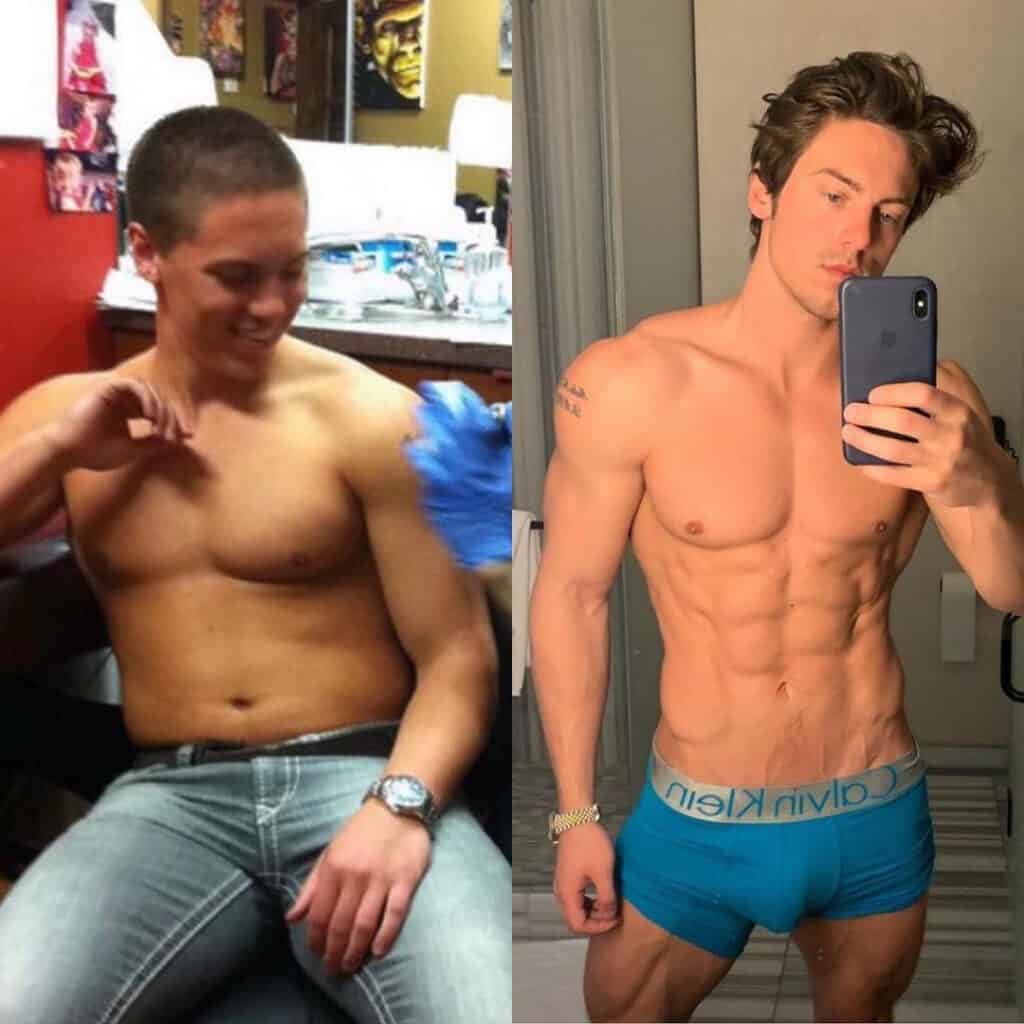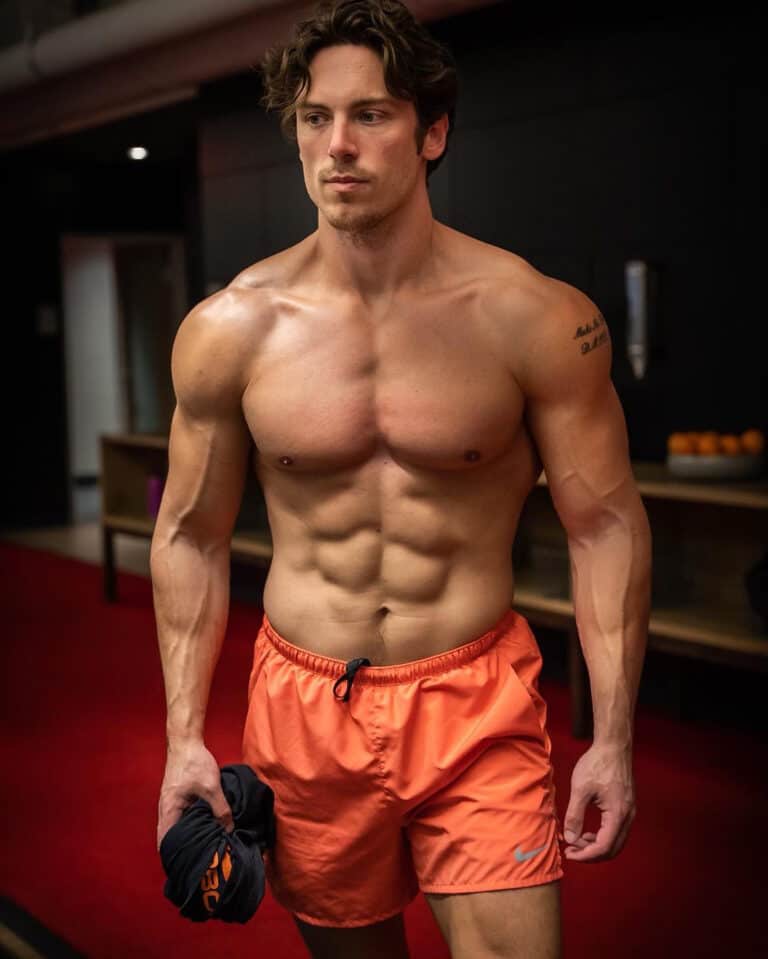
You walk in the gym and notice this guy bench pressing 315 pounds. You’re impressed by his strength and hope to reach that level one day. Then the guy gets up and you realize that he’s about your size. How come you’re still struggling to add two plates onto the bar, but this guy can do reps with three? He’s not even that buff.
Drugs? Maybe.
Genetics? Possibly.
No matter what though, he didn’t just decide to bench press for the first time and lifted 315 pounds. He got there by using the progressive overload principle… and so can you.
You don’t have to build massive amounts of muscle to get stronger. In fact, your relative strength — strength-to-bodyweight ratio — is more important than the sheer size of your arms or chest. A 180-pound guy benching 315 pounds is much more impressive than a 300-pound guy lifting the same weight.
In this article, you’re going to learn how to increase your relative strength with progressive overload.
What Is Progressive Overload?
Muscles respond to the resistance placed upon them and get stronger to adapt. To stimulate muscle growth, you need to overload them with heavy weights. However, if you keep training with the same weight at the same rep range, muscles adapt to the load and they no longer get bigger or stronger. Why would the muscle get stronger if it can already handle the stress you inflict upon it?
This is where progressive overload gets useful. Instead of lifting the same weights week-in and week-out, you increase the weight, reps or sets slowly. This way, you keep challenging your muscles to grow and get stronger.
Beginners can increase weight rapidly. If you’re just starting out, you should be able to increase the weights you lift every workout by 5-10 pounds. As you get stronger and reach intermediate status, your progress will naturally slow down. You may be able to add 5-10 pounds every three-to-four weeks, or you can progress by using micro-plates (1 to 2.5 pounds on each side of the bar).
Advanced lifters often struggle to add weight to the bar. They need to optimize every aspect of their life to ensure they still progress, albeit slowly, and avoid plateaus. A night of poor sleep or a day of bad food choices can affect their progress in the gym.
If you’re an intermediate or advanced lifter and struggle with your progress, the Double Progression Model in the Greek God 2.0 Program accelerates your progression without the need of microplates.

The Double Progression Model
The simplest way to progress is to add the smallest weight available to each side of the barbell or use a heavier dumbbell. However, most gyms don’t carry plates lighter than five pounds and dumbbells go up by only five pounds.
It may be easy to add 10 pounds to your lifts at the beginning of your weightlifting journey, but once you get stronger it won’t be possible to progress every week.
With the double progression model, you won’t only progress with weights but also with reps. For each workout, you’ll work in a rep range, like 4-6 reps for example. Keep lifting the same weight until you hit the top end of the rep range. Once you get there, increase the weight and go back to the bottom end of the rep range.
Progressive Overload With Reverse Pyramid Training
If you follow the Greek God 2.0 program or any other Kinobody programs, you will use reverse pyramid training for the heavy, compound lifts. With this training method, you lift the heaviest weight on your first set, then drop the weight by 10 percent and up the reps for each consecutive set.
When you implement the double progression model to reverse pyramid training, focus on progressing on your first set. When you get stronger on your first set, the following sets will progress automatically.
Here’s what it looks like with incline bench press:
Incline Press (Set 1):
- Workout 1: 200 pounds x 5 reps
- Workout 2: 205 pounds x 4 reps
- Workout 3: 205 pounds x 5 reps
- Workout 4: 210 pounds x 4 reps
- Workout 5: 210 pounds x 5 reps
- Workout 6: 215 pounds x 4 reps
Progressive Overload With Rest-Pause Training
Another training method Kinobody programs utilize often is rest-pause training. With this method, pick a lighter weight, perform 12-15 reps on your first set, rest only for 10-15 seconds and perform three more sets of 4-6 reps, using the same weight and rest time.
You can progress with rest-pause training as well. Use the same weight until you hit the top end of the rep-range in each set (15, 6, 6, 6). Once you can perform 15 reps on your first set and 6 reps on each consecutive set, you’re ready to use a heavier dumbbell.
Here’s what it looks like with lateral raises:
Lateral Raise:
- Workout 1: 15 pounds x 15 reps, 6 reps, 6 reps, 6 reps
- Workout 2: 20 pounds x 12 reps, 4 reps, 4 reps, 4 reps
- Workout 3: 20 pounds x 13 reps, 5 reps, 5 reps, 4 reps
- Workout 4: 20 pounds x 14 reps, 6 reps, 6 reps, 5 reps
- Workout 5: 20 pounds x 15 reps, 6 reps, 6 reps, 6 reps
- Workout 6: 25 pounds x 12 reps, 4 reps, 4 reps, 4 reps
You can progress slower or faster than the examples given above. The important part is to aim to reach the top end of the rep range in each set. Once you get there, increase the weight until you can’t.
Age is just a number: Reveal Your Younger Self With Will Smith’s ‘Gemini Man’ Workout
How to Break Through Plateaus?
Using the double progression model, you’ll get strong faster than you thought it was possible. However, you can’t possibly progress every single week forever. If you could, you’d become the strongest person on the planet within a year or two. Strength plateaus are inevitable.
Once you hit a strength plateau, instead of getting bummed out or continuing to do the same thing, switch it up and get stronger on a different exercise working the same body part.
By changing the exercise, not only will you keep getting stronger, but you’ll also give your muscles a different stimulus. Muscles adapt to the exercise after a while, and unless you’re increasing the weights and reps, they stop responding. However, using a different exercise will stimulate muscle growth again, because the muscles aren’t adapted to that exercise.
For example, if you’re stuck on the incline bench press, switch to incline dumbbell press. You will notice that you’re not as strong on the dumbbell press because it’s a new skill you need to get good at. This will create a new stimulus for your pecs and they’ll start growing again.
Progressive Overload During a Cut
Progressive overload is useful to get bigger and stronger, but what if that’s not your goal? What if you’re actually trying to lose fat?
Many people make the mistake of ignoring their strength during a cut and just focus on burning calories with cardio or lift lighter weights with high rep-ranges. It may work to lose weight on the scale, but by maintaining your strength and muscle mass, you keep your metabolism high, thus giving your body a chance to burn more calories throughout the day. (Not to mention, you’ll look much better with higher muscle mass.)
As mentioned at the beginning of the article, relative strength is more important than overall strength. Even if you’re not able to progress during the cut, your relative strength is still increasing as you lose weight and maintain your strength. If you lift 200 pounds while weighing 200 pounds, that’s lifting 1 times your body weight. If you lose 20 pounds and maintain your strength, now you’re lifting 1.11 times your body weight; you’ve gained 11 percent relative strength for that exercise!
Whether you’re trying to build muscle or lose fat, implementing progressive overload is crucial to reach your goals. However, consistency is required for progressive overload to work for you. Therefore, it is best to choose a program that’s proven to work and stick to it instead of hopping from one program to another.
This is where Kinobody programs come into play. By far the simplest and most effective workout programs on the market, we get crazy physique transformations all the time. Plus, lifelong Kino Warriors can tell you all about the sustainability of this lifestyle approach to fitness and nutrition.





